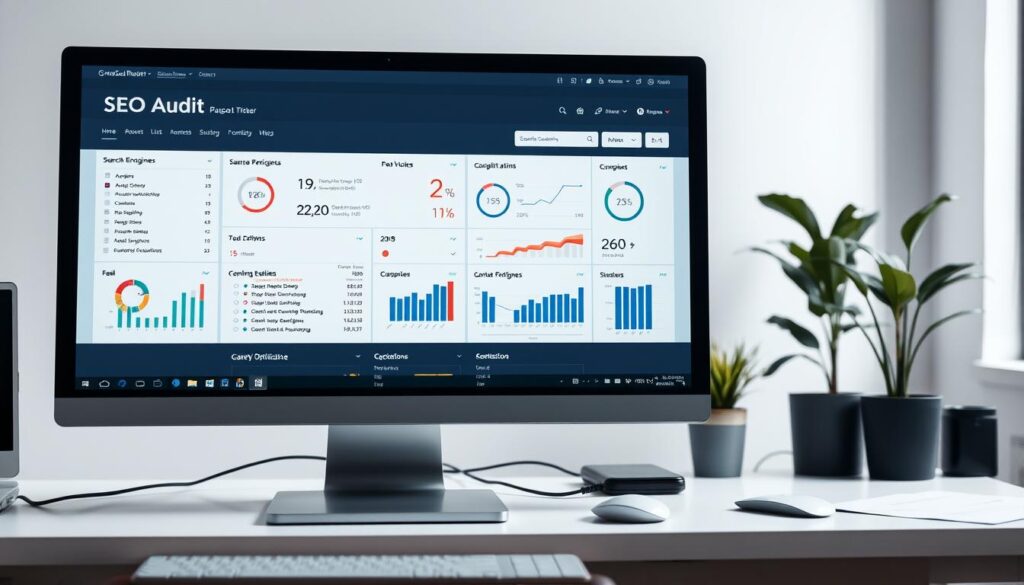In today’s world, knowing Technical SEO well is key to get higher search engine rankings. It makes your website work better, too. To be good at SEO strategies, you should pay attention to technical stuff, on-page, and off-page SEO. Work on your site often to keep it running great and showing up in search results.
Technical SEO helps a lot with making your site better. It can make your site easier to use on phones and help computers understand your site better. Doing regular checks and updates is very important. It helps bring more visitors to your site without paying for ads.
Want to know more about Technical SEO? Read this detailed article on Technical SEO.
Key Takeaways
- Technical SEO is very important for getting your site to show up more in search results and to work smoothly.
- Good SEO means looking at technical details, what’s on your pages, and how your site links to others.
- Keep improving and checking your site to make it easier to find online.
- Using structured data and schema markup makes it easier for search engines to understand your site’s content.
- Doing SEO checks regularly helps catch and fix any problems early, so they don’t mess up how your site works.
Understanding the Fundamentals of Technical SEO
Getting the hang of SEO means knowing Technical SEO‘s big role. It’s all about making sure your website talks well to search engines. This is behind-the-scenes work. It makes your site easy for search engines to crawl and index. Unlike on-page SEO and off-page SEO, Technical SEO keeps your site visible.
What is Technical SEO?
Technical SEO makes your website’s technical side better so more people can find it on search engines. It includes making sure search engine crawling is smooth and content indexing works well. Also, it’s about your website loading fast and being easy to use on phones.
Importance of Technical SEO
Technical SEO is super important. It helps search engines get what your site is about. Without it, even awesome content might not be seen. Fast site speed and a good user experience also help your site rank better.
Technical SEO vs. On-Page SEO vs. Off-Page SEO
Technical SEO fixes the back end of your site. On-page SEO deals with your site’s content and setup, like meta tags and keywords. Then, off-page SEO means getting good backlinks and social media attention. All three work together for a strong SEO plan.
Implementing Effective Site Architecture
Designing a site that’s easy to use is key to getting noticed on the internet. It’s important for a site to be well-organized. This helps search engines and people use your site better.
Crawlability and Indexability
Crawlability means search engines can look through a site easily. A site that’s easy to crawl tells search engines it’s well put together. Making sure your site is indexable means search engines can find and show your pages. This helps more people see your site and makes your SEO work better.
URL Structures and Breadcrumbs
Having the right URLs and breadcrumbs is very important. URLs with the right keywords make your site easier to understand and use. This also makes your site easier to crawl.
Breadcrumbs let people find their way back home easily. They make your site easier to use and help with indexability. Breadcrumbs guide users, helping them see how your site is organized.
| Site Component | SEO Benefit | Best Practices |
|---|---|---|
| URL Structure | Improves crawlability | Use short, keyword-rich URLs |
| Breadcrumbs | Enhances indexability | Incorporate clear breadcrumb trails |
| Site Hierarchy | Optimizes overall site architecture | Maintain a logical and consistent structure |
Optimizing Site Speed and Performance
Making your website faster is key to a better user experience and boosts its performance. Quick pages keep users happy and help with search engine spots. Let’s look at ways to make a site faster.
Improving Page Load Times
How fast a page loads can really impact how people interact with your site. Making images smaller is a big first step for speed. Using WebP formats, and squishing them without losing quality makes pages pop up faster.
Using browser caching and making CSS, JavaScript, and HTML smaller also speeds things up. This makes your site quicker and smoother to use.
Utilizing Content Delivery Networks (CDNs)
Content Delivery Networks or CDNs are super helpful for making your site swift. They spread your site’s content across the globe, making it faster for people far away. This means your website loads quickly everywhere, even during busy times.
Mobile Optimization Strategies
Smartphones have changed how we use the internet. Mobile optimization is now key for websites to rank well. Google’s mobile-first indexing shows how important it is. A mobile-first design boosts SEO and makes your site easier to use.
Importance of Mobile-First Design
Mobile-first design means you start with the mobile version of your site. Then, you adjust it for desktops. This method makes sure your site works great on phones.
Many people browse the internet on their phones. Focusing on these users makes your site easier to access. A site that’s easy to use keeps visitors around. This helps your SEO rankings.
Implementing Responsive Design
Responsive design lets your site work well on all devices. It changes your site’s layout and size to match the screen. A responsive web design makes everything fit perfectly, no matter the device.
To create a responsive site, use flexible grids and scalable images. Also, CSS media queries help. These steps make your site good-looking and functional everywhere. Being adaptable boosts usability and meets search engine needs.
Here’s a table comparing mobile-first and responsive web design:
| Aspect | Mobile-First Design | Responsive Web Design |
|---|---|---|
| Initial Focus | Mobile Devices | All Devices |
| Development Approach | Prioritize mobile elements add desktop features gradually |
Start with a flexible grid ensure layout works on any device |
| SEO Impact | High | High |
| Usability | Optimized for mobile | Consistent |
Structured Data and Schema Markup
Websites need structured data and schema markup to rank higher on search engines. This makes your site’s content easy for search engines to understand. This increases visibility and gets more clicks. Let’s look at what structured data is and how to use schema markup.
Types of Structured Data
Structured data comes in various types. Each has a special use. Here are some you might see:
- Local Business: Provides details about a business, including name, address, and contact information.
- Product: Offers specifics about products, such as price, availability, and reviews.
- Article: Used for news articles, blog posts, and similar content to appear more attractive in search results.
- Recipe: Contains details on cooking recipes, including ingredients, cooking times, and ratings.
Implementing Schema Markup for Enhanced Visibility
Schema markup helps your website rank better. It makes your content clearer to search engines. You add special tags to your site’s HTML. This gives search engines more info about your content.
Let’s compare what happens when you add structured data:
| Type of Schema Markup | Impact on Search Rankings | Benefits |
|---|---|---|
| Local Business | High | Improves local search visibility |
| Product | Medium | Enhances product listings in searches |
| Article | Medium | Increases click-through rates by providing rich snippets |
| Recipe | Low | Makes recipe content more accessible and engaging |
Using structured data and schema markup well boosts your site’s visibility. Your search rankings improve and web traffic goes up.
Conducting Regular SEO Audits
Keeping your website healthy is key for staying on top in search rankings. With regular SEO audits, you spot and fix problems that hurt your site. You can make sure your site is in top shape by using smart SEO tools.

Tools for Technical SEO Audits
Some tools are a must for doing good SEO audits. Google Search Console tracks how your site does and points out issues like crawl errors. Screaming Frog gives deep details about your site’s structure and health.
Below is a quick look at some critical SEO tools:
| Tool | Primary Function | Key Features |
|---|---|---|
| Google Search Console | Performance Monitoring | Index Coverage, Mobile Usability, Keywords |
| Screaming Frog | Site Crawling | Page Titles, Meta Data, URL Structures |
Common Issues and Fixes
In SEO audits, you often find problems like broken links, copied content, or slow pages. Fixing these fast is key to keeping your site healthy.
- Broken Links: Find and fix or remove them with a link checker.
- Duplicate Content: Use canonical tags or 301 redirects to stop content copying.
- Slow Page Load Times: Make images smaller, use browser caching, and consider using CDNs.
Doing SEO audits regularly helps fix problems. This makes your website healthier and better ranked.
Handling Duplicate Content
Duplicate content can hurt your website’s SEO and lower its search engine rankings. It’s important to know what it is and how to handle it. This keeps your online presence strong.
One key way to deal with duplicate content is canonical tags. They help search engines know which page version to show. This is a top SEO best practice.
It’s also crucial to have unique, valuable content on your site. This makes for a better user experience. Plus, it makes search engines see your site as more credible. Using a good content management system helps a lot.
Here’s a comparative table showcasing methods to resolve duplicate content issues:
| Method | Description | Effectiveness |
|---|---|---|
| Canonical Tags | Specify the preferred version of a URL | High |
| 301 Redirects | Redirect duplicate pages to the main version | Medium |
| Unique Content Creation | Ensure all content is unique across the site | High |
| Meta Noindex Tags | Prevent search engines from indexing certain pages | Low |
Using these methods can solve duplicate content issues. They also boost your search engine rankings. Canonical tags and good content management help keep your site’s reputation strong. They make your website more engaging and effective for users.
Building a High Domain Authority
Building a high domain authority helps make your website trusted and seen more in search results. It’s key to get good backlinks from strong sources through link building. These backlinks show search engines that your site is worth visiting.
Using smart content marketing helps a lot too. By making and sharing great content, you pull in visitors. You also get nice sites to link to you. This makes your website more credible and helps with SEO.
Good link building means asking well-known sites to work with you. This could mean writing posts for them or teaming up. Getting high-quality backlinks is a major goal. Also, keeping your site clean from bad backlinks and running smoothly is vital.
In summary, getting good backlinks, smart marketing, and a smooth-running site are key. These steps boost your site’s trust and search engine ranking.
Conclusion
SEO success is crucial for long-term growth. In this article, we covered key tactics for good technical SEO. These include understanding basics and improving your website’s structure.
Making your website fast and easy to use on phones is important. Also, use structured data to stand out more.
It’s vital to check your SEO regularly. This helps find problems to fix for better results. Keeping up with SEO updates helps you stay ahead.
In the end, making a plan for SEO is key. Always improve and change as SEO does. Use what you learn from data to be the best in searches.
